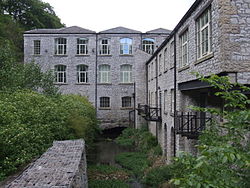Litton Mill
 |
|
| Cotton | |
|---|---|
| Water spinning mill | |
| Client | Ellis Needham and Thomas Frith |
| Further ownership |
|
| Coordinates | 53°15′14″N 1°45′43″W / 53.254°N 1.762°WCoordinates: 53°15′14″N 1°45′43″W / 53.254°N 1.762°W |
| Construction | |
| Built | 1782 |
| Demolished | 1874- New mill built |
Litton Mill is a textile mill at Millers Dale, near Tideswell in Derbyshire.
The original 19th-century mill became notorious during the Industrial Revolution for its unsavoury employment practices, luridly described by the commentators of the day, and the testimony of Robert Blincoe, a parish apprentice who had been indentured to work at the mill.
It was set up in 1782 by Ellis Needham and Thomas Frith, both farmers with small estates in the area. The mill was powered by the water of the River Wye, using Richard Arkwright's water frame. It could be said that the company was doomed from the start. Needham, in particular, had sunk most of his assets into the venture. The valley was particularly isolated and transport for the raw material and finished goods was poor. Moreover they had difficulty in attracting a workforce.
The early spinners, such as Arkwright and Strutt, had been able to attract the families of weavers and , so-called "free labour" meaning the employees were not indentured. Meanwhile Evans at Darley Abbey could draw on a pool of labour from the town of Derby. In contrast, the area around Litton was sparsely populated by farming people who were scornful of the new cotton industry.
By 1786 the, barely profitable, mill was put up for sale. There were no buyers and Needham and Frith struggled on. Needham's money had gone and he was farming on rented land, while Frith left the partnership in 1799.
The Poor Law Act of 1601 had, among its provisions "the putting out of children to be apprentices". An agreement was made between the churchwarden and an employer, by means of an indenture sworn before a Justice of the Peace, that the latter would provide for and give employment and training to a pauper child. Often this worked for the benefit of the child but often it was seen by employers as a source of cheap labour and a way for a parish to relieve itself of responsibility. In the absence of any local labour, this was the course taken by Needham and Frith.
...
Wikipedia

